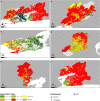Geospatial distribution of intestinal parasitic infections in Rio de Janeiro (Brazil) and its association with social determinants
- PMID: 28273080
- PMCID: PMC5358884
- DOI: 10.1371/journal.pntd.0005445
Geospatial distribution of intestinal parasitic infections in Rio de Janeiro (Brazil) and its association with social determinants
Abstract
Background: Intestinal parasitic infections remain among the most common infectious diseases worldwide. This study aimed to estimate their prevalence and provide a detailed analysis of geographical distribution of intestinal parasites in the metropolitan region of Rio de Janeiro, considering demographic, socio-economic, and epidemiological contextual factors.
Methods/principal findings: The cross-section survey was conducted among individuals attending the Evandro Chagas National Institute of Infectious Diseases (FIOCRUZ, RJ) during the period from April 2012 to February 2015. Stool samples were collected and processed by sedimentation, flotation, Kato-Katz, Baermann-Moraes and Graham methods, iron haematoxylin staining and safranin staining. Of the 3245 individuals analysed, 569 (17.5%) were infected with at least one parasite. The most common protozoa were Endolimax nana (28.8%), Entamoeba coli (14.8%), Complex Entamoeba histolytica/Entamoeba dispar (13.5%), Blastocystis hominis (12.7%), and Giardia lamblia (8.1%). Strongyloides stercoralis (4.3%), Schistosoma mansoni (3.3%), Ascaris lumbricoides (1.6%), and hookworms (1.5%) were the most frequent helminths. There was a high frequency of contamination by protozoa (87%), and multiple infections were observed in 141 participants (24.8%). A positive association between age (young children) and gender (male) with intestinal parasites was observed. Geospatial distribution of the detected intestinal parasitic infections was not random or homogeneous, but was influenced by socioeconomic conditions (through the material deprivation index (MDI)). Participants classified in the highest levels of deprivation had higher risk of having intestinal parasites.
Conclusions/significance: This study provides the first epidemiological information on the prevalence and distribution of intestinal parasitic infections in the Rio de Janeiro metropolitan area. Intestinal parasites, especially protozoa, are highly prevalent, indicating that parasitic infections are still a serious public health problem. MDI showed that intestinal parasites were strongly associated with the socioeconomic status of the population, thus making it possible to identify social vulnerable areas.
Conflict of interest statement
The authors have declared that no competing interests exist.
Figures




References
Publication types
MeSH terms
LinkOut - more resources
Full Text Sources
Other Literature Sources
Miscellaneous

